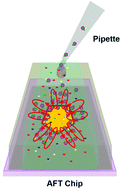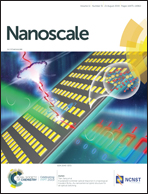Trapping of sub-100 nm nanoparticles using gigahertz acoustofluidic tweezers for biosensing applications†
Abstract
In this study, we present a nanoscale acoustofluidic trap (AFT) that manipulates nanoparticles in a microfluidic system actuated by a gigahertz acoustic resonator. The AFT generates independent standing closed vortices with high-speed rotation. Via careful design and optimization of geometric confinements, the AFT was able to effectively capture and enrich sub-100 nm nanoparticles with a low power consumption (0.25–5 μW μm−2) and rapid trapping (within 30 s), showing significantly enhanced particle-operating ability as compared to its acoustic and optical counterparts; using specifically functionalized nanoparticles (SFNPs) to selectively capture target molecules from the sample, the AFT led to the molecular concentration enhancement of ∼200 times. We investigated the feasibility of the SFNP-assisted AFT preconcentration method for biosensing applications and successfully demonstrated the capability of this method for the detection of serum prostate-specific antigen (PSA). The AFT was prepared via a fully CMOS-compatible process and thus could be conveniently integrated on a single chip, with potential for “lab-on-a-chip” or point-of-care (POC) nanoparticle-based biosensing applications.



 Please wait while we load your content...
Please wait while we load your content...